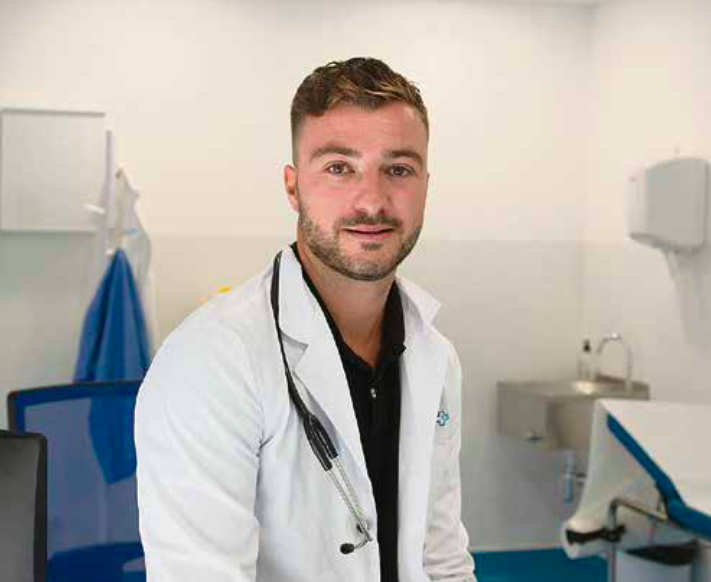

PROPOFOL ROMFARM

Ask a doctor about a prescription for PROPOFOL ROMFARM

How to use PROPOFOL ROMFARM
INSTRUCTIONS for medical use of the medicinal product METROVIOLE DENTA
Composition:
active substances: metronidazole benzoate, chlorhexidine gluconate;
1 g of gel contains metronidazole benzoate in terms of metronidazole - 10 mg, a solution of chlorhexidine gluconate 20% in terms of chlorhexidine digluconate - 0.5 mg;
excipients: carbomer, propylene glycol, sodium saccharin, disodium edetate (Trilon B), tromethamine, lemon oil, purified water.
Pharmaceutical form
Gel for gums.
Main physical and chemical properties
Gel of white or almost white color with a specific smell.
Pharmacotherapeutic group
Antimicrobial and antiseptic preparations for local use in stomatology. ATC code A01A V.
Pharmacological properties
Pharmacodynamics
Antimicrobial combined preparation for complex treatment and prevention of some infectious and inflammatory diseases of the oral cavity.
The effectiveness of the medicinal product is due to the presence of two antibacterial components - metronidazole and chlorhexidine.
Metronidazole - a derivative of nitroimidazole, which has antiprotozoal and antibacterial action. Active against anaerobic bacteria that cause periodontal diseases: Porphyromonas gingivalis, Prevotella intermedia, Prevotella denticola, Fusobacterium fusiformis, Wolinella recta, Eikenella corrodens, Borrelia vincenti, Bacteroides melaninogenicus, Selenomonas spp.
Chlorhexidine - an antiseptic with bactericidal action. Its action is to increase the permeability of bacterial cell walls, as a result of which chlorhexidine penetrates into the bacterial cytoplasm, leading to cell death. Active against a wide range of vegetative forms of gram-negative (Treponema spp., Neisseria gonorrheae, Trichomonas spp., Chlamydia spp., Ureaplasma spp., Bacteroides fragilis) and gram-positive microorganisms, as well as yeast, dermatophytes, and lipophilic viruses.
Some strains of Pseudomonas spp. and Proteus spp. have low sensitivity to chlorhexidine, while acid-resistant bacteria and bacterial spores are not susceptible to the action of this substance. Chlorhexidine does not impair the functional activity of lactobacilli.
Pharmacokinetics
The minimum inhibitory concentration (MIC50) of metronidazole for anaerobic bacteria is less than 1 μg/ml. When the preparation is applied locally (applied to the gums), the concentration of metronidazole in the gum area is significantly higher than when the preparation is taken orally, and the level of systemic absorption of metronidazole when applied locally is significantly lower than when taken orally. The preparation is well absorbed from the gastrointestinal tract and can be detected at an inhibitory level for bacteria in the blood and saliva within 1 hour after administration. Metronidazole metabolism occurs mainly in the liver. The main route of excretion of metronidazole and its metabolites is the kidneys. Reduced kidney function does not change the pharmacokinetics of a single dose of metronidazole.
In case of accidental swallowing of an excess of chlorhexidine during its local use as part of a dental gel, about 1% of the dose that enters the stomach is absorbed from the gastrointestinal tract. Chlorhexidine is not cumulative in the body and is minimally metabolized.
Clinical characteristics
Indications
For the treatment of infectious and inflammatory diseases of the periodontal tissues and mucous membrane of the oral cavity:
- catarrhal hypertrophic gingivitis, acute and chronic course;
- acute ulcerative-necrotic gingivitis (Vincent's gingivitis);
- generalized periodontitis, chronic and exacerbated course;
- trauma to the mucous membrane of the oral cavity caused by dental prostheses;
- alveolitis (inflammation of the socket after tooth extraction)
For the prevention of exacerbations of chronic gingivitis and periodontitis.
Contraindications
Increased sensitivity to metronidazole, chlorhexidine, as well as derivatives of nitroimidazole and any components that are part of the medicinal product.
Contraindicated in patients with confirmed blood dyscrasia or blood dyscrasia in history.
Contraindicated in patients with diseases of the peripheral and central nervous system.
Special precautions for use
Avoid getting the gel into the eyes.
Interaction with other medicinal products and other types of interactions
When used locally in recommended doses, no systemic interaction of Metrovial Denta gel with other medicinal products has been detected. However, caution should be exercised when prescribing Metrovial Denta gel with certain medicinal products.
Warfarin and other coumarin anticoagulants. Metronidazole enhances anticoagulant action, leading to an increase in prothrombin time.
Disulfiram. Simultaneous use enhances the toxicity of the preparations, which can lead to the development of neurological symptoms.
Phenobarbital, phenytoin, anticonvulsants based on hydantoin. When used simultaneously with metronidazole, the antimicrobial activity of the latter is reduced. The reason is the accelerated metabolism of metronidazole.
Cimetidine. Inhibits the metabolism of metronidazole, which can cause an increase in metronidazole concentration in blood serum.
Alcohol. Metronidazole causes intolerance to alcohol. Simultaneous consumption of alcohol and metronidazole can cause symptoms of toxic psychosis, nausea, hypotension, tachycardia, diaphoresis, or shortness of breath, and in some cases, severe hypotension and shock may occur. These reactions usually occur within 24 hours but may occur within a period of up to 2 weeks after alcohol consumption.
Features of use
The use of the medicinal product Metrovial Denta does not replace hygienic tooth cleaning.
During the use of the preparation, it is not recommended to consume alcohol, as this can lead to the occurrence of stomach spasms, nausea, vomiting, headache, and flushing of the face.
Metronidazole should not be used simultaneously with disulfiram, as it can cause psychotic reactions and confusion.
Prolonged use can cause brown discoloration of teeth and tongue.
The use of Metrovial Denta gel can cause temporary changes in taste sensations.
Use during pregnancy or breastfeeding
The medicinal product should not be used during pregnancy.
Breastfeeding should be stopped during treatment with the preparation.
Ability to affect reaction speed when driving vehicles or using other mechanisms
The use of the medicinal product in the specified dose does not affect the ability to drive vehicles or potentially hazardous mechanisms.
Method of application and doses
Locally, only for dental use!
The preparation should be used after consultation with a dentist.
For adults with gum inflammation (gingivitis), Metrovial Denta gel should be applied to the gums using finger massage or a cotton swab 2 times a day. After applying the gel, the mouth should not be rinsed, and food and liquids should not be consumed for 30 minutes. The average duration of treatment is 7-10 days.
In case of periodontitis: after removal of dental deposits, periodontal pockets should be treated with Metrovial Denta gel, and the gel should also be applied to the gums. The duration of application is 30 minutes. The number of procedures depends on the severity of the disease. Further applications of the gel are performed by the patient independently. Metrovial Denta gel should be applied to the gum area 2 times a day for 7-10 days.
For the prevention of exacerbations of chronic gingivitis and periodontitis, Metrovial Denta gel should be applied to the gums 2 times a day for 7-10 days. Preventive treatment courses should be conducted 2-3 times a year.
For the treatment of post-extraction alveolitis after tooth extraction, the socket should be treated with Metrovial Denta gel, and then the patient should use the gel independently 2-3 times a day for 7-10 days.
For the prevention of exacerbations of chronic gingivitis and periodontitis, Metrovial Denta gel should be applied to the affected areas 2 times a day for 7-10 days. Preventive treatment courses should be conducted 2-3 times a year.
For the prevention of exacerbations of chronic gingivitis and periodontitis, in case of gum bleeding and unpleasant odor from the mouth, in the evening after hygienic tooth cleaning, Metrovial Denta gel should be rubbed into the gum area using finger massage or a cotton swab for 2-3 minutes, after which the mouth should not be rinsed.
In order to prevent exacerbations in patients with catarrhal gingivitis and generalized periodontitis of mild degree, in the morning and evening after hygienic tooth cleaning, Metrovial Denta gel should be rubbed into the gum area using finger massage or a cotton swab for 2-3 minutes, after which the mouth should not be rinsed and liquids should not be consumed for 1 hour. Preventive treatment courses lasting 2 weeks should be conducted 2-3 times a year.
Children
The medicinal product is not recommended for use in children (under 18 years).
Overdose
Cases of overdose of Metrovial Denta gel when used locally are unknown.
Accidental or intentional swallowing of a large amount of gel may lead to an exacerbation of side effects that were initially caused by metronidazole (chlorhexidine is practically not absorbed from the gastrointestinal tract). These reactions include nausea, vomiting, dizziness. In more severe cases, paresthesia and convulsions may be observed. High doses and prolonged systemic treatment with metronidazole are associated with the development of leukopenia, neutropenia, increased risk of peripheral neuropathy, and toxicity of the central nervous system. For the treatment of overdose, it is necessary to rinse the stomach and, if necessary, conduct symptomatic therapy.
Side effects
When used locally, the risk of developing systemic side effects of Metrovial Denta gel is negligible; however, sometimes reactions described below may be observed.
From the immune system: allergic reactions, including skin rash, itching, urticaria, angioedema, anaphylaxis, including anaphylactic shock. One case of eyelid edema has been described as a manifestation of angioedema.
From the nervous system: headache.
From the organs of vision: when the gel gets on the area near the eyes, lacrimation, dryness of the mucous membrane, and short-term redness may occur.
From the gastrointestinal tract: metallic taste in the mouth, bitter taste in the mouth, nausea, possible appearance of plaque in the oral cavity, on the surface of teeth and tongue.
Reactions at the application site: burning sensation at the application site, irritation at the application site.
Data from post-marketing studies
When used orally, chlorhexidine may cause hypersensitivity, including symptoms of anaphylaxis, oral irritation, tooth and tongue discoloration, increased formation of dental calculus, changes in taste sensations, bitter taste in the mouth, as well as burning, numbness, dryness, and pain in the oral mucosa.
During post-marketing use, there have been reports of urticaria with swelling of the face, lips, mouth, throat, and a feeling of itching, difficulty breathing, hoarseness, loss of consciousness, as well as allergic reactions (anaphylaxis) in the oral cavity on open wounds.
In case of appearance of these or other undesirable effects, treatment should be stopped, and a doctor should be consulted.
Shelf life
3 years.
The medicinal product should not be used after the expiration date specified on the packaging.
Storage conditions
Store in the original packaging at a temperature not exceeding 25 °C. Store in a place inaccessible to children.
Packaging
20 g in aluminum or laminated tubes in a pack or without a pack.
Release category
Without a prescription.
Manufacturer
PrJSC Pharmaceutical Factory "Viola".
Location of the manufacturer and its address
Ukraine, 69063, Zaporizhzhia, Amosov Street, 75.
- Country of registration
- Active substance
- Prescription requiredYes
- Manufacturer
- This information is for reference only and does not constitute medical advice. Always consult a licensed doctor before taking any medication. Oladoctor is not responsible for medical decisions based on this content.
- Alternatives to PROPOFOL ROMFARMDosage form: emulsion, 10 mg/mlActive substance: propofolManufacturer: Корден Фарма Соціета' Пер АзіоніPrescription requiredDosage form: emulsion, 10 mg/ml, 20 mlActive substance: propofolManufacturer: АТ "ФармакPrescription requiredDosage form: emulsion, 20 mg/ml, 20 ml in ampouleActive substance: propofolManufacturer: АТ "ФармакPrescription required
Alternatives to PROPOFOL ROMFARM in other countries
The best alternatives with the same active ingredient and therapeutic effect.
Alternative to PROPOFOL ROMFARM in Spain
Alternative to PROPOFOL ROMFARM in Poland
Online doctors for PROPOFOL ROMFARM
Discuss dosage, side effects, interactions, contraindications, and prescription renewal for PROPOFOL ROMFARM – subject to medical assessment and local rules.














